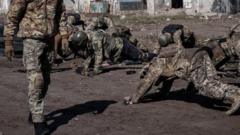What Happens When You Encounter Death for the First Time at Age 8?

# The Bosnian War: A Journey from Trauma to Resilience
## Summary
The Bosnian War, which erupted in the early 1990s, was a harrowing chapter in European history marked by ethnic cleansing, violence, and deep human suffering. For those who lived through it, like the narrator of this story, it was a time that stripped away not only homes but also families, identities, and the very essence of childhood. This article seeks to explore the personal and collective impacts of the Bosnian War, examining how trauma can resonate through generations and how resilience can emerge from the darkest experiences. Through the lens of individual stories, we will uncover the importance of remembering the past, the role of education in healing, and the need for vigilance against the ideologies that fueled such atrocities.
## Understanding the Bosnian War
### Historical Context
The Bosnian War took place between April 1992 and December 1995, following the breakup of Yugoslavia. It was characterized by ethnic conflict primarily between Bosniaks (Bosnian Muslims), Serbs, and Croats. The war was marked by a campaign of ethnic cleansing, particularly against Bosniaks, leading to the deaths of approximately 100,000 people and the displacement of millions.
### Prelude to Conflict
Before the war, Bosnia and Herzegovina was known for its ethnic diversity and cultural richness. The region was home to Bosniaks, Serbs, Croats, and others who coexisted in relative harmony. However, rising nationalism among the various ethnic groups, fueled by political leaders, sowed seeds of distrust and division.
### The Beginning of the War
In April 1992, the war officially began with the siege of Sarajevo, leading to widespread atrocities. The narrative of the conflict is filled with stories of resilience, loss, and hope, showing how ordinary people were caught in the crossfire of political ambitions and ethnic hatred.
## The Personal Impact of War
### A Childhood Lost
For many, like the narrator, the innocence of childhood was shattered as the war loomed closer. The transition from playing childhood games to “playing soldiers” was indicative of a loss of safety and stability. Children who once enjoyed cartoons found themselves grappling with the harsh realities of survival.
#### The Emotional Toll
The emotional toll of the war is profound. The narrator recounts the moment when their mother was found crying in front of the television—a moment that symbolized the overwhelming fear and helplessness that many families felt. This emotional trauma often manifests in various ways, including post-traumatic stress disorder (PTSD), which can persist long after the conflict has ended.
### Displacement and Loss
As the war progressed, families were forced to flee, leading to a sense of dislocation and loss. The narrator describes moving 14 times in the first nine months, highlighting the instability and uncertainty that defined the lives of many refugees. The loss of family members, such as fathers and uncles, added to the trauma endured by those who survived.
#### The Role of Family
Family became a crucial support system during these tumultuous times. The bond between the narrator and their mother, along with their aunt, illustrated the resilience and resourcefulness of women in the face of adversity. Cooking with limited resources became a symbol of survival and defiance against the horrors surrounding them.
## The Concentration Camps: A Dark Chapter
### The Reality of Concentration Camps
The narrative touches on the grim reality of concentration camps, a stain on humanity that emerged during the war. The systematic rounding up of Muslim men, including the narrator’s father, highlighted the brutal nature of ethnic cleansing. The psychological scars left by such experiences are often irreversible.
#### The Cost of Survival
The harrowing experiences within the camps are often too painful to articulate. Those who endured such conditions frequently struggle with the memories, as evidenced by the narrator’s father, who lost significant weight and the ability to talk about his experiences.
### The International Response
The role of organizations like the International Committee of the Red Cross (ICRC) became vital in securing the release of prisoners. The eventual reunion of the narrator’s family was a bittersweet moment, filled with relief but also overshadowed by the trauma they had endured.
## Rebuilding Life After War
### A New Beginning in the UK
The transition from war-torn Bosnia to life in the UK was fraught with challenges. The family’s arrival in Newcastle marked the start of a new chapter, but it was also a time of adjustment and healing. The emotional scars of war often linger, manifesting in nightmares and anxiety.
#### Education as a Path to Healing
Education emerged as a vital tool for rebuilding life. The narrator’s pursuit of architecture not only provided a sense of purpose but also became a means of expressing their experiences. Education plays a crucial role in breaking the cycle of trauma, allowing survivors to reclaim their narratives and futures.
## The Importance of Sharing Stories
### From Survivor to Advocate
The narrator’s journey from survivor to advocate showcases the power of storytelling in healing. By sharing personal experiences, they have contributed to a greater understanding of the Bosnian War and its lasting impacts. This process of sharing helps to honor the memories of those lost while also fostering empathy and awareness among others.
#### Establishing the Bosnian Genocide Educational Trust
The establishment of the Bosnian Genocide Educational Trust marked a significant step in promoting education about the war and its consequences. By engaging with schools, communities, and policymakers, the trust aims to ensure that the lessons of the past are not forgotten.
## Vigilance Against Hate and Division
### The Current Landscape
The resurgence of far-right rhetoric and nationalist movements across Europe raises concerns about the potential for history to repeat itself. The narrator’s observations about contemporary political discourse highlight the importance of remaining vigilant against ideologies that promote division and dehumanization.
#### Lessons from the Past
The experiences of survivors serve as a reminder of the need for compassion, understanding, and dialogue in our communities. By recognizing the humanity in others, we can work towards a future that prioritizes peace and justice.
## Conclusion
The Bosnian War left an indelible mark on those who lived through it, shaping their identities and futures. The journey from trauma to resilience is complex and ongoing, but it is also filled with hope and the possibility of healing. Through storytelling and education, survivors can transform their pain into powerful narratives that inspire change.
As we reflect on the lessons learned from the Bosnian War, we are reminded of the importance of empathy, understanding, and vigilance against hatred. The legacies of trauma and resilience continue to shape our world, urging us to strive for a future where love and compassion triumph over division and hatred.
How can we ensure that the stories of survivors are heard and remembered in our quest for peace? #BosnianWar #Resilience #HumanRights
## FAQs
### What were the main causes of the Bosnian War?
The Bosnian War was primarily caused by rising nationalism among the various ethnic groups in Bosnia and Herzegovina, political instability following the breakup of Yugoslavia, and the desire for territorial control.
### How did the war affect children in Bosnia?
Children in Bosnia faced immense challenges during the war, including displacement, loss of family members, and exposure to violence. Many experienced trauma, which can lead to long-term psychological effects.
### What can be done to prevent future genocides?
Preventing future genocides requires a commitment to education, promoting human rights, fostering dialogue among diverse communities, and taking a stand against hate and discrimination.
Published: 2025-07-11 05:00:00 | Category: News



